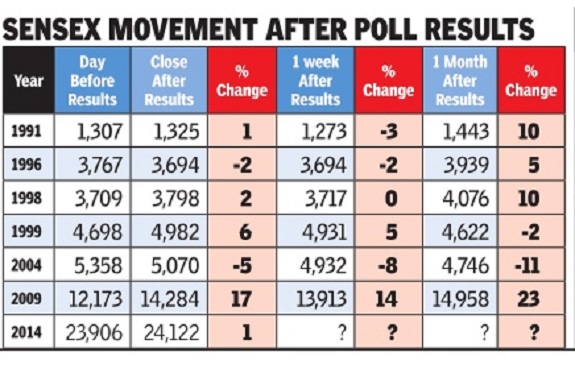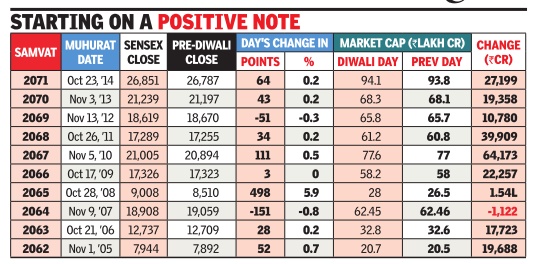Sensex
This is a collection of articles archived for the excellence of their content. |
History, milestones
1986-2021 Jan
Payal Bhattacharya, January 22, 2021: The Times of India

From: January 22, 2021: The Times of India

From: Partha Sinha, January 22, 2021: The Times of India

From: Partha Sinha, January 22, 2021: The Times of India
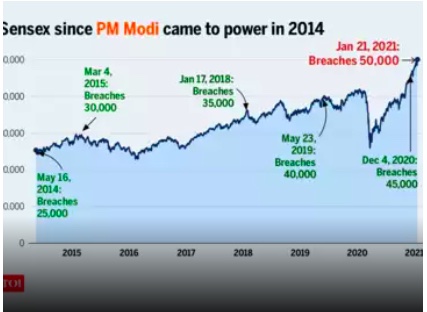
From: Payal Bhattacharya, January 22, 2021: The Times of India
See graphics:
The Sensex, 1979-1997
The Sensex, 1999- 2021 Jan
The Sensex, 2001-2021
The Sensex, 2014- Jan 2021
How the journey began
Created in 1986, sensex is the oldest stock index in India. It comprises 30 of the largest and most actively traded stocks on the Bombay Stock Exchange (BSE).
The index was launched with a base price of 100 (base year 1978-79).
The term sensex was coined by Deepak Mohoni, a stock market analyst. It is a blend of the words 'sensitive' and 'index'.
After its launch, sensex was calculated based on market-capitalisation weighted methodology. Since September 2003, it began to be calculated based on a free-float capitalisation method.
Major milestones achieved
The 30-share index experienced enormous growth since India opened up its economy to the world in 1991. It rose from around 5,000 points in early 2000 to 50,000 in January 2021.
It crossed the 25,000-mark for the first time on May 16, 2014 as the Bhartiya Janta Party (BJP)-led NDA government came to power with a sweeping majority.
It took almost 4 more years to jump to the 35,000-mark.
A repeat win of the Narendra Modi-led BJP lifted the sensex past the 40,000 landmark for the first time ever. Interestingly, the sensex has nearly doubled today since Modi came to power in 2014.
Journey from 45,000 to 50,000
Sensex jumped from 45,000 mark to 50,000 in a short span of just over a month. The index took 35 sessions to scale this feat.
In just seven sessions in 2021, the sensex notched up over 1,500 points to race past 48,000-mark and 49,000-mark backed by record foreign fund flows.
How Covid impacted markets
From witnessing gigantic losses to record-shattering gains, investors went on a roller-coaster ride amid the coronavirus pandemic and massive stimulus measures during the year 2020.
The coronavirus pandemic forced the government to announce a nationwide lockdown to curb its spread. As the number of cases rose, massive global selloff pushed the sensex off a cliff in late March 2020.
However, markets staged a massive comeback and jumped nearly 91 per cent in just over 10 months to breach the 50,000-mark.
Ironically, the stock market has seen more gains than losses in the post Covid phase.
Since recovering from its record slump, sensex has been scaling new highs, thereby making investors richer with every peak and deepening their market participation.
Overall, the sensex gained 15.7 per cent while the broader NSE Nifty jumped 14.9 per cent during the year.
IT and pharma stocks were the major gainers as health concerns rose and work from home led to rise in internet usage.
Amongst the global indices, sensex staged the most significant recovery of 80 per cent, after Nasdaq which staged a recovery of 86 per cent.
Comparison with other macroeconomic indicators
India’s per capita income has witnessed a steady increase since the 1990s. However, the economic growth has lost momentum and hasn't kept pace with the rise of sensex.
Even when the economy is experiencing its worst slump in almost 40 years, the sensex has continued to scale fresh record peaks.
M-cap of BSE-listed companies nears Rs 200 lakh crore
The market capitalisation (m-cap) of BSE listed companies is now nearing Rs 200 lakh crore-mark. It is also pulling the country's m-cap to GDP ratio near parity.
M-cap is the price of individual shares multiplied by the total number of shares in the issue.
The market rally over the past few months has pushed the mcap to GDP ratio beyond 80 per cent. This implies a marked improvement from the two-year average of 75 per cent.
1986> 2021 Jan: The consistent stocks
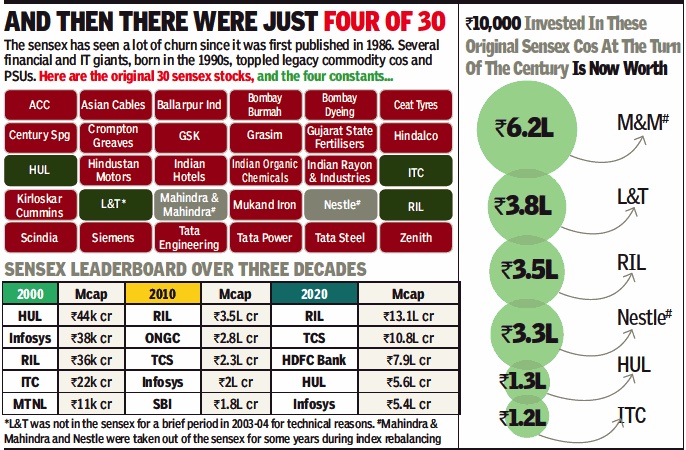
From: January 22, 2021: The Times of India
See graphic:
1986> 2021 Jan: The consistent stocks on Sensex.
The economy and the Sensex
1990-2020

From: Mayur Shetty, January 22, 2021: The Times of India
See graphic:
The economy and the Sensex, 1990-2020
1979-2021 Jan/ GDP
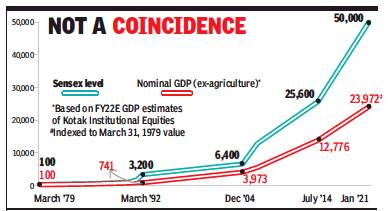
From: Prashant Jain, January 22, 2021: The Times of India
See graphic:
India’s GDP and the Sensex, 1979-2021 Jan
Changes in Sexsex indices
Biggest falls
2006-15
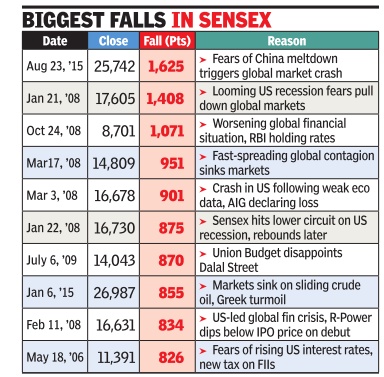
See graphic, Biggest falls in Sensex, 2006-15
2008-15
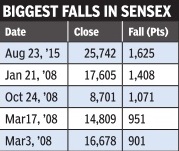
See graphic, Biggest falls in Sensex: 2008-15
In a single-day
2008- 2020 March

From: March 10, 2020: The Times of India
See graphic:
The Biggest single-day Crashes in the Indian stock market, 2008- 9 March 2020
Changes in stock market indices
1979-2019
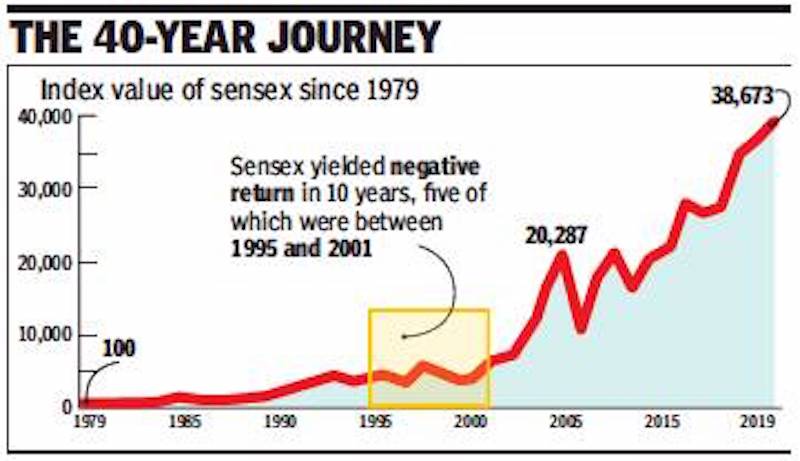
From: Partha Sinha, A ₹1L investment in sensex in ’79 would have risen to ₹3.9cr on April 2, 2019, April 2, 3019: The Times of India

From: Partha Sinha, A ₹1L investment in sensex in ’79 would have risen to ₹3.9cr on April 2, 2019, April 2, 3019: The Times of India
As the sensex topped 39,000 for the first time ever, it also quietly crossed another landmark. It was exactly 40 years ago, on April 1, 1979, that the sensex was technically born, starting its journey with a base value of 100 points. In effect, in 40 years, the sensex has risen 390 times. Seen another way, if one had invested Rs 1 lakh in the index on that day, the investment would have been worth Rs 3.9 crore today.
The BSE started publishing the value of the sensex only from 1985 when it was in the 400-point range. The same year it gave the highest annual returns, 94%, while in 2008, it had more than halved, from over 20,000 to a little over 9,600.
‘For any investor, sensex ideal way to make money’
On Monday, boosted by strong global cues, the sensex opened nearly 200 points higher at 38,859, scaled a new all-time peak at 39,116 and closed at 38,872, up 199 points on the day.
The tremendous returns generated by the sensex is a testimony to the power of wealth creation of the stock market, provided the investor is able to withstand the ups and downs that the market throws up once in a while. “People who get scared by volatility and do not stay the journey do not benefit from (the power of) compounding,” said Rajeev Thakkar, fund manager, Parag Parikh Long Term Equity Fund. Also, for investors, it is not advisable to look at stock prices frequently, he said.
Over the last 40 years, India has been witness to the assassination of one Prime Minister and one ex-PM, testing of nuclear bombs, two major stock market scams, a war and several major border skirmishes with Pakistan, terror attacks like 9/11 and 26/ 11, pledging of golds to avoid sovereign debt default and fall of governments at the Centre. Yet, for the index over these 40 years, the average annual retur n was a little over 16%. In comparison, according to some estimates, bank FDs of one-year duration would have given annual average returns of about 7% while the returns from gold would have been in the 9% range.
According to Gajendra Kothari, MD & CEO, Etica Wealth Management, a financial advisory firm, the sensex’s returns over these four decades clearly demonstrates the magnitude of wealth created in the Indian stock market during these years. “Had a retail investor who didn’t know anything about selecting stocks and had no experience of tracking his investments invested in the index, he would have multiplied his wealth several hundred times,” he said. “For any investor, the sensex remains the ideal way to make money. By investing in this index, he participates in the India growth story by having an exposure to 30 best companies in the country,” Kothari said.
1992-2020
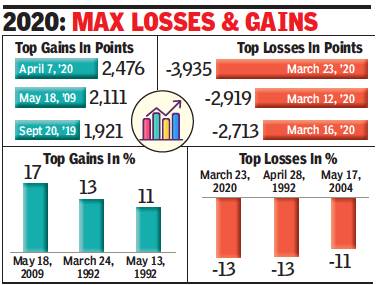
From: Mayur Shetty, January 22, 2021: The Times of India
See graphic:
1992-2020: the biggest losses and gains in the Indian stock market
2014-15
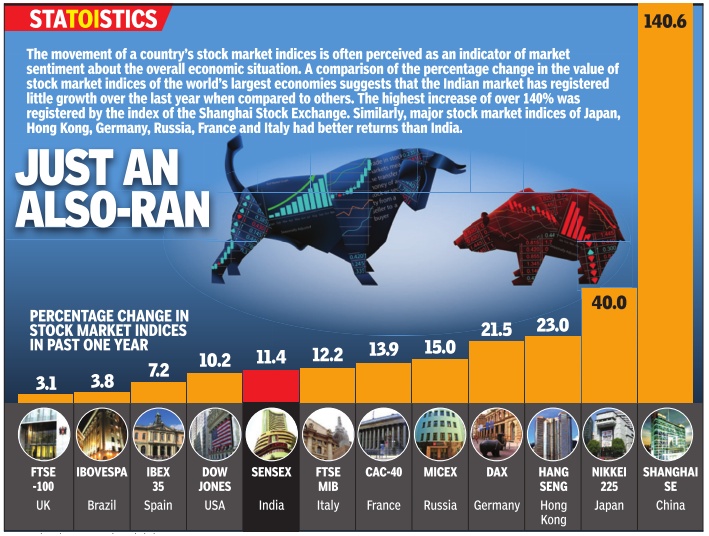
See graphic:
Percentage change in stock market indices in 2014: India and the world
Election results and the Sensex
1991-2014
Sensex: on the morning after the results
See graphic:
Sensex movement after poll results, 1991-2014
2015-18
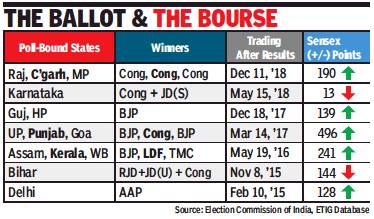
From: Sensex dives, then discounts BJP setback, December 12, 2018: The Times of India
See graphic:
Election results and the Sensex- 2015-18
2019
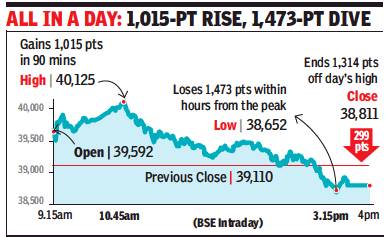
From: May 24, 2019: The Times of India
See graphic, ' Sensex movement after election results, 2019 '
Mondays that are manic
2008-15
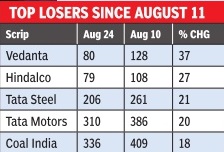
See the graphics,
Biggest falls in Sensex: 2008-15 (It is under 'Biggest falls' elsewhere on this page)
and
Top losers since August 2011
The Times of India, Aug 25 2015
7 of 10 biggest mkt slumps on Mondays
They don't call it Manic Monday for nothing. Seven of the 10 biggest single-day falls on Dalal Street have taken place on a Monday. This is true for both intra-day crashes as well as sensex closing levels.The second highest closing fall of 1,408 points was also on Monday, January 21, 2008.
Monsoons and the market: the correlation
2009, 2011: no correlation
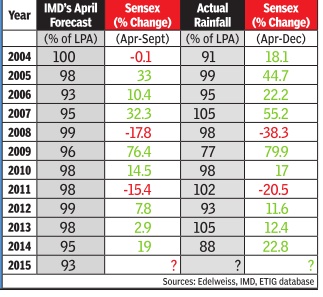
Apr 24 2015
Although Dalal Street is feeling the jitters of a below-normal monsoon prediction by the Indian Meteorological Department, data show no correlation between Met's predictions, actual rains and the overall market trend. For example, 2009 saw the worst drought in recent times with the country witnessing 77% of the long period average (LPA) rainfall during monsoon.However, that year the sensex rallied 76% between April, when Met's initial monsoon estimates are published, and September, when the monsoon officially ends. On the other hand, the sensex fell over 20% in 2011, the year that saw one of the best monsoons in over a decade
Muhurat day trading
Samvat 2061-71 (2005-15)
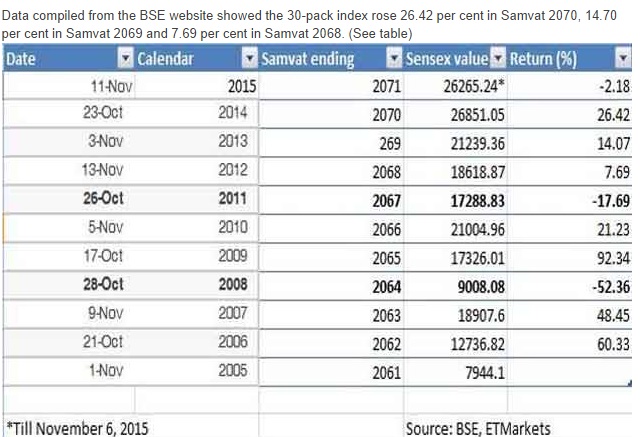
Amit Mudgill, ECONOMICTIMES.COM Nov 9, 2015
Samvat 2071 3rd worst for Sensex in a decade
(Data compiled from the BSE…)
It was the third worst Samvat in a decade for BSE benchmark Sensex, as a less-than-expected pace of earnings revival, fading hopes of big-bang reforms and high volatility in equity markets globally had a bearing on the domestic market.
With just one day left for investors to participate in the auspicious muhurat trading, investors would not hope to see a repeat of Samvat 2071, during which the BSE Sensex shed some 2 per cent. The fall, though minuscule, has ended a long winning streak for the BSE benchmark in three consecutive Samvats. The Hindu Samvat runs from Diwali to Diwali. Data compiled from the BSE website showed the 30-pack index rose 26.42 per cent in Samvat 2070, 14.70 per cent in Samvat 2069 and 7.69 per cent in Samvat 2068. (See table)
The equity benchmark has given negative returns in only three Samvats in last one decade. Besides the Samvat that is ending on Tuesday, Samvat 2070 (2010-11) witnessed a 17.69 per cent fall in the Sensex while Samvat 2067 (year 2007-2008) saw the index lose 52 per cent.
Calendar 2011 had witnessed the downgrading of the US to AA+ from AAA rating by rating agency Standard & Poor's for the first time in history, triggering weakness in equities across the globe. During 2007-2008, markets crashed globally after the collapse of Lehman Brothers, as many other US financial institutions, such as Freddie Mae and Fannie Mac, faced trouble, triggering a chain reaction, what is now known as the global financial crisis.
However, Samvat 2071 was different in the sense that global markets fell this time on concerns over a slowing Chinese economy and the strengthening of the US economy, which has made a liftoff imminent after eight years of near-zero interest rate regime.
For minute-by-minute market/stock updates, follow our Twitter handle @ETMarkets
Back home, a delay in delivery on reforms by the NDA government weighed on the market sentiment through the Samvat.
"The May 2014 election result was a landmark in Indian politics, as the Modi-led NDA coalition won an outright majority in the Lok Sabha. The fact that a single party crossed the halfway mark on its own for the first time in 30 years raised hopes that the long-awaited economic reforms will be out on fast track. However, things have not gone smoothly, largely due to the BJP's lack of a majority in the Rajya Sabha. As a result, reforms that require legislative approvals -- notably the emblematic and key land acquisition and GST reforms bills -- are stuck in a parliamentary logjam," Vivek R Mishra, Asia Equity Strategist, Societe Generale, said in a note.
"Our sense is that there is a serious structural change that has taken place globally between emerging and developed markets," said Jahangir Aziz, JPMorgan.
In an interview with ET Now, Aziz said: "If you look at global trade, it has flatlined both in terms of US dollar and as a percentage of global GDP since 2010. If you look at what drove the fortunes of emerging markets, including India, prior to the crisis or through the recovery phase, it was this massive increase in global trade. It is not a six-month or 12-month phenomena, it has been happening since 2010."
"In addition, the kind of impact that growth in developed markets used to have on emerging markets has been more or less absent in last five years. So if you look at the last five years, developed markets have actually increased growth rates from, say, minus half a per cent during the crisis period to about one-and-a-half per cent. But emerging markets have more or less lost about 350 to 400 basis points in average growth rate. The old model has come to its end," he said.
2014: rises marginally
Sensex rises marginally in Muhurat trading
The Times of India Oct 25 2014
At any gathering of brokers, analysts and investors, a major part of the conversation currently revolves around the new government and its policies. Thursday evening's Muhurat trading session at P J Towers, the headquarters of BSE in south Mumbai, which saw the sensex closing 64 points higher at 26,851, was no different. Top brokers and independent money managers shared their views on almost every decision of the Narendra Modi government and its impact on the market, and there were enough number of willing listeners as the one-and-halfhour long special trading session continued at the exchange's Convention Hall.
During the session, which was to mark the start of Samvat Year 2071 -the New Year for the trading community on Dalal Street dominated by the Gujaratis -the sensex's gains were backed mainly by index heavyweights like Reliance Industries, TCS and ITC. Nifty closed 19 points higher at 8,015.
Usually, the indices close higher after the Muhurat session as traders do not sell shares during this session that is preceded by a puja of God dess Lakshmi, who symbolizes wealth and prosperity .
The day's session at BSE started with felicitation of some of the top brokers on the exchange during the past one year, and then the opening bell ringing ceremony . This year, Bollywood actor Kajal Aggarwal, of “Singham“ fame, rang the opening bell. In Samvat 2070, the sensex had gained 26%.
There was a bullish undertone in what the brokers, money managers and analysts had to say as they have huge expectations from the Modi government. However, there were some notes of caution as well.
Samvat 2070-74; 2074 was among most volatile
Samvat 2074 ends as one of most volatile yrs for sensex, November 7, 2018: The Times of India
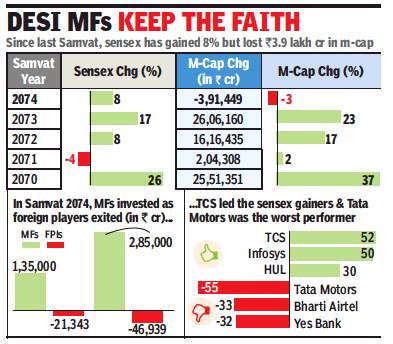
Samvat 2074- Investments by (Indian) mutual funds and foreign players in
From: Samvat 2074 ends as one of most volatile yrs for sensex, November 7, 2018: The Times of India
As the Samvat year 2074 ended with a 41-point sensex gain, it brought to an end one of the most volatile years in the last decade: The index rallied from a little over 32k to an all-time high of almost 39k, only to fall sharply to about 33k before finally settling at nearly 35k.
The Samvat, a traditional Hindu calendar year, will be remembered for the sensex outperforming most of the other broader indices as large-cap stocks rallied, while some of the small- and mid-cap stocks were hammered ruthlessly on Dalal Street.
As a result, despite the 8.3% rise in the sensex, the BSE’s mid-cap index lost 8%, while the small-cap index lost over 15% during the year. The sharper losses in mid- and small-cap stocks also led to a dip in investors’ wealth by Rs 3.9 lakh crore with the BSE’s market capitalisation now at Rs 140.4 lakh crore.
The year also recorded one of the sharpest outflows by foreign funds, mainly because of rising crude oil prices, that led to some sharp weakness in the rupee, which nearly touched 75 to a dollar in mid-October before ending the Samvat at 73 — a depreciation of over 12% during the year. Official data shows that FPIs have started taking money out of India at an increasing rate in the last few months with a nearly Rs 40,000-crore net outflow from stocks since September itself. However, the net inflow figures of the initial months have given the data some respectability with the net outflow at Rs 21,343 crore.
Foreign funds also sold in the debt segment with the net outflow figure at almost Rs 47,000 crore. This huge selling also had an impact on the yields in the bond market with the 10-year benchmark yield hardening by more than one percentage point to over 8.2% in early October, but ended the year at 7.8% on the back of a liquidity infusion by the RBI.
The year also witnessed emergence of domestic mutual funds as the counter-balance to foreign funds, with systematic investment plans (SIPs) rising to become a game changer in the stock market. With inflows of about Rs 7,500 crore (that’s around $1 billion) each month flowing into mutual funds and not much option to buy stocks outside India, domestic money managers cushioned sharp selling by foreign funds, industry players said.
2014-15/ Samvat 2071: Worst in four years
The Times of India, November 11, 2015
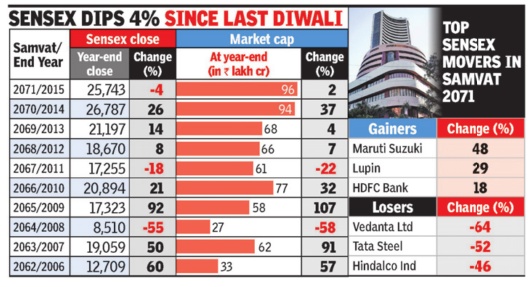
Samvat 2071 in the traditional calender of the trading community on Dalal Street, has turned out to be the worst year for the sensex in terms of returns in the last four years. The benchmark index lost 4% even as investors waited for the 18-monthsold Narendra Modi government to deliver on its promises of faster economic growth and development. In terms of investors' wealth, however, the year saw about Rs 2 lakh crore being added to BSE's market capitalization at Rs 96.1lakh crore, reflecting smarter gains for nonsensex stocks. Newly listed stocks like Interglobe Aviation (IndiGo airlines) and Coffee Day Enterprise (Cafe Coffee Day), which together have contributed about Rs 35,000 crore worth of market value, also contributed to investors' wealth during Samvat 2071, exchange data showed.
The year, which started strong, ended on a cautious note for investors on the back of the Bihar drubbing suffered by the Modi-led NDA. However, the go od sign for Dalal Street is that two days after the elections results were out, the government liberalized foreign investment rules in 15 sectors, including manufacturing, defence, banking and agriculture through executive orders. This was “reflective of the government's commitment to boost investment as well as improve the ease of doing business“, said a note from Radhika Jain, partner, Walker Chandiok & Co LLP , an management consultancy and advisory firm.
Market players said it was a good sign that the poll drubbing is not forcing the government to take the populist route and dump the economic reforms process for growth and development. Some analysts said the poll debacle may turn out to be a blessing in disguise for the government and the economy . Others feel the Modi government would be less effective to take the legislative route to reforms given its minority position in the Rajya Sabha and therefore will depend more on executive decisions to get the reforms process moving forward. In such a situation, investors willing to stay invested for the long run will benefit.
“It will be a tough year for the market, especially considering the pipeline of primary issues and government divestments,“ said Arun Kejriwal, director, KRIS. “Making money will entail discipline and skill sets. Reforms will galore over the next 2-3 quarters. However, it will take longer for tangible results to be seen,“ Kejriwal said.
2017: biggest ever fall on Muhurat day
See graphic:
How the Sensex closed on Muhurat day, compared to the previous day, Samvat 2064-2074 (A.D. 2007-2017)
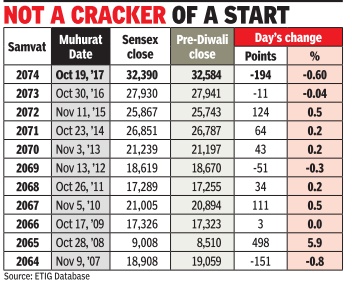
From: October 20, 2017: The Times of India
2015/ Samvat 2072: Best gains in 7 years
The Times of India, Nov 12 2015
Sensex's best Muhurat gains in 7 yrs
Rises 124 points on 1st day of samvat 2072 trading on govt's FDI move
The Muhurat day trading for Vikram Samvat year 2072, the new year for the Hindu lunar calendar, ended on a strong note, thanks mainly to the government's late Tuesday announcement allowing easier foreign investment in 15 sectors, with the sensex ending 124 points higher, its best Diwali day closing in seven years. Although the mood among those present at BSE's Convention Hall was downbeat compared to last year when the Modi-led government was just a few months old, veterans at Dalal Street said the Centre was working hard and its decisions relating to the economic reforms process is expected to start showing results soon.
On Diwali day , brokers worship Lakshmi, the Godess of wealth and prosperity at BSE's Convention Hall which used to be the trading rink till computers replaced the open outcry system of trading. Brokers, along with their family members, trade on terminals set up temporarily for the Muhurat session at the same hall. According to another official at a broking house, the government's attempts to bo ost investment in the economy is bearing results, albeit slowly , and some private sector companies are also starting to invest in building capacities.
The gains on Diwali day's one-and-half hours special trading session was led by Axis Bank, Sun Pharma and L&T, while Hero MotoCorp and ITC were the top laggards. The session also added nearly Rs 63,500 crore to investors' wealth with the BSE's market capitalisation now at Rs 96.78 lakh crore. Institutional participation was minimal as it was a banking holiday . Extending its gains for the third straight day, gold prices advanced by Rs 15 to Rs 26,250 per ten grams in muhurat trading at the bullion market on increased buying by jewellers, driven by the ongoing festive season.
Token buying activity on the auspicious occasion of Diwalialso supported the upside, traders said. Silver also edged up by Rs 25 to Rs 34,900 per kg. AGENCIES
2022/2078: worst performing here in seven years
Aseem Gujar, Oct 22, 2022: The Times of India
Mumbai : Samvat 2078 has turned out to be the worst-performing year for the sensex in seven years even as investor wealth increased by over Rs 11 lakh crore since last Diwali. The sensex closed the year flat at 59,307 on Friday. The 0. 8% decline since last Diwali meant that the sensex slipped into the red for the first time since Samvat 2071 (calendar year 2015), when it had sunk 4%.
Vikram Samvat, which is about 57 years ahead of the Gregorian calendar and starts on the day of Diwali, is followed mainly by the trading community on Dalal Street. The ‘muhurat’ trading, an hour-long special evening session at the BSE, will be on October 23.
The muted performance in Samvat 2078 came after the sensex rallied 38% — a 12-year record — in the previous year. Even during Samvat 2076, when the pandemic broke out, the sensex had risen 11% despite extreme volatility.
The Omicron variant was the first pain-point for investors. It was followed by the invasion of Ukraine by Russia in February, which wreaked havoc on global supply chains and pushed up energy & commodity prices. The third blow came from the relentless rate hikes by the US Federal Reserves to counter soaring inflation, which led to flight of foreign institutional investors. The ongoing economic slowdown in China, rate hikes in Indiaand the sliding rupee have added to bearishness among investors.
Market players said that buying by domestic institutional investors like mutualfunds helped cushion the sensex’s fall.
A global market weakness notwithstanding, every month retail investors have consistently invested around Rs 12,000 crore in mutual funds, most of which have been deployed in equities. Since last Diwali, foreign institutional investors have net sold about Rs 1. 9-lakh-crore stocks, while domestic funds have net purchased over Rs 2-lakh-crore equities.
The addition of Rs 11 lakh crore to BSE’s market capitalisation at Rs 277 lakh crore reflected smarter gains for non-sensex stocks. A part of the gains also came from a handful of high-profile market debuts of companies like LIC, Paytm and Nykaa. Over Rs 8 lakh crore of the market cap rise came from Adani Group stocks alone.
2080 Samvat, 2023
Nov 13, 2023: The Times of India

From: Nov 13, 2023: The Times of India
See graphic:
How the Sensex closed on Muhurat day, compared to the previous day, 2019-23
Samvat year and Muhurat date, 2019-23
Mumbai : Dalal Street investors were richer by about Rs 46 lakh crore during Samvat year 2079 that ended with net buying of Indian stocks by foreign and domestic investors together worth over Rs 3.2 lakh crore.
The two leading indices — the sensex and Nifty — showed gains of about 9.5%, compared to a marginal negative close in last Samvat year 2078 and a 38% gain in 2077. It was also the year of PSU bank stocks, which made a stellar run on the bourses with NSE’s PSU banking index giving a return of over 53% since last Diwali.
Vikram Samvat, which is about 57 years ahead of the Gregorian calendar and starts on the day of Diwali, is follo wed by the trading community on Dalal Street.
Total investors’ wealth, reflected by BSE’s market capitalisation, was at Rs 323 lakh crore, from Rs 277 lakh crore, offi cial data showed. The rise in investors’ wealth came on the back of strong buying by foreign funds who net pumped in Rs 1.4 lakh crore and domestic institutions, who net bought stock worth 1.9 lakh crore.
Samvat year 2079 was the year of midand small-cap stocks with foreign and domestic funds pumping in large amounts of funds into these stocks, market players said. As a result, BSE’s small-cap index gained a little over 34% while the midcap index was up 31%, BSE data showed. Stock prices of nine government-owned banks more than doubled during the year of which two — J&K Bank and UCO Bank — tripling in value.
The year also witnessed one of the most damning corporate activities in recent times. In late January, Hindenburg attacked the Adani group with several charges, which the conglomerate has denied. However, the selloff in Adani stocks wiped off Rs 13 lakh crore market cap.
NSE vis-à-vis the Sensex
As in 2015
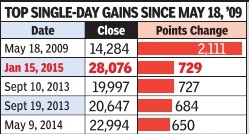
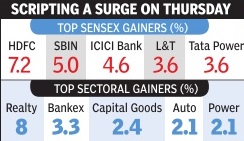
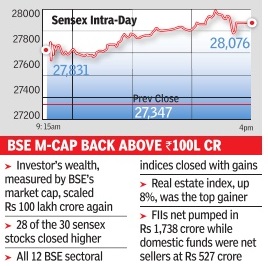
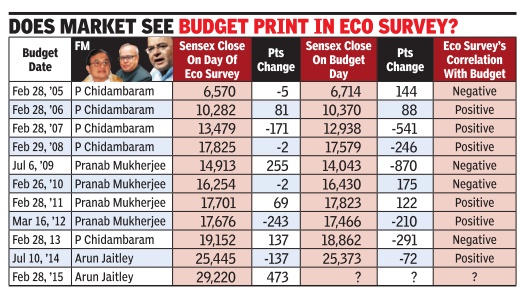
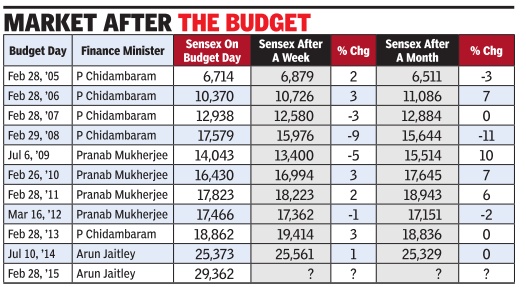
NSE top bourse, but sensex bigger brand
Partha Sinha The Times of India Mar 05 2015
A little more than two decades ago, the National Stock Exchange (NSE) -currently the largest bourse in India in terms of turnover -was created by the government to compete with and break the monopoly of the Bombay Stock Exchange. BSE then was a cosy brokers' club with a complete dominance over the stock trading in the country . To counter trading by a limited number of brokers, the gov ernment created an exchange that was the country's first computer-driven online stock exchange, promoted by some of the leading institutions of that time.
In its initial days, NSE enjoyed the monopoly of setting up trading terminals across the country , while its main rival BSE was not allowed to do so. It was only after NSE captured a large chunk of share trading across the country and also dominated regional stock exchanges that BSE got the permission to go pan-In dia. That, too, after a huge struggle by BSE brokers.
What helped NSE to outwit BSE and grow rapidly was the savvy use of technology . The launch and spread of online trading, which also created several jobs among the youth, was a big differentiator. According to one institutional dealer, in mid-1990s, he got his first job with a family-run broking firm simply because he had very basic knowledge of computers. “My employer would treat me with a lot of respect and would often brag to fellow brokers that he had someone who knew computers,“ the dealer said.
Along with computerized trading, NSE also led the automation and paperless trading in the Indian market. NSDL, the first depository in the country is a subsidiary of NSE that led the demat revolution in India. Also, it was the first exchange to have a clearing corporation, an independent third party that facilitated settlement and helped low er trading and settlement risks in the market.
Despite the dramatic rise and rise of NSE, at least on one count it still falls behind BSE: The Brand. Sensex as a brand that punches way above its weight compared with NSE's nifty. “Although most of the brokers look at nifty to gauge investor sentiment, outside of this community , among the general mass, sensex still remains the primary gauge for the robustness of the market and the economy ,“ said a former exchange official.
Prime Ministers and the Sensex
1999- 2019, May

From: April 17, 2019: The Times of India

From: April 17, 2019: The Times of India
See graphics:
The performance of the Sensex under the Prime Minister Atal Bihari Vajpayee, 1999- May 2004
The performance of the Sensex under two Prime Ministers Manmohan Singh and Narendra Modi, 2004- May 2019
Union Budget, annual: impact of
2017> 2016: Sensex gains 30% on retail push
Sensex has gained 30% since last Budget on retail push, February 1, 2018: The Times of India
See graphic:
Between Jan 31 2017 and Jan 31 2018, Sensex touched new highs 70 times
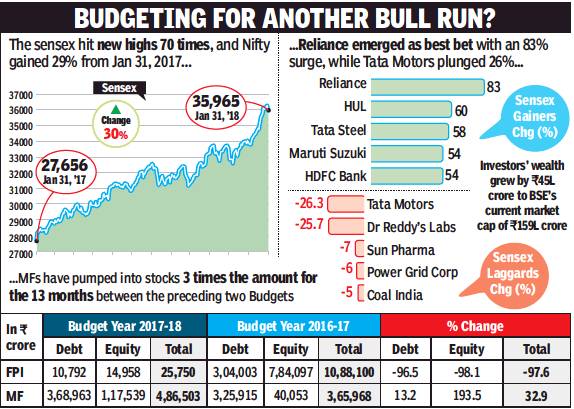
From: Sensex has gained 30% since last Budget on retail push, February 1, 2018: The Times of India
MFs Pump ₹1.2L Cr Into Stocks, Foreign Investors Only ₹15K Cr
If one looks at the performance of sensex, Nifty and top stocks on Dalal Street since the last Budget exactly a year ago, the numbers will surely impress. The sensex is up around 30% since then to a record high of around 36k, it has hit new highs on more than 70 occasions, and investors are richer by nearly Rs 45 lakh crore (or about $700 billion) with BSE’s market capitalisation now at nearly Rs 160 lakh crore, also an all-time peak.
What could impress more and also give a lot of comfort to the government and policymakers is the fact that this smart rally came mainly on the back of strong buying by retail investors through domestic mutual funds. Since the last Budget, mutual funds have pumped close to Rs 1.2 lakh crore into stocks — almost three times the corresponding number over the 13-month period between Budget 2016-17 and Budget 2017-18 (for FY17, the Budget was presented on February 29, while since then the date has been advanced to February 1). In comparison, net fund infusion by foreign investors — who were the most dominant investor group in India for nearly a quarter of a century — was just a trickle at nearly Rs 15,000 crore (or $2.3 billion).
With retail investors lapping up the systematic investment plan (SIP) in mutual fund schemes as their preferred route to invest in the stock market, fund managers and brokers believe that India’s longcherished dream of having a credible counter-balance to foreign funds is firmly in place.
Investors are putting over Rs 6,200 crore into mutual funds through SIPs every month and industry estimates say 95% of this is intended for investing in equities.
If the current trend is maintained, very soon Indian investors will be investing over $1billion (Rs 6,500 crore) in stocks every month, which could rise to over Rs 10,000 crore in about two years, A Balasubramanian, chairman of industry trade body AMFI, told TOI recently. In January 2017, this number was at Rs 4,095 crore, thus recording a growth rate of over 50% since finance minister Arun Jaitley’s last Budget.
One of the main reasons for this huge growth in SIP inflows is what market players describe as the ‘financialisation of savings and investments’ due to demonetisation, which is getting a further boost by introduction of GST.
These two reform-oriented moves by the government are prompting investors to shift from buying gold and real estate to investing in mutual funds, stocks and other financial products.
Dalal Street veterans now expect the FM to give a further boost to financial savings by putting more money into the hands of salaried people and also plugging loopholes which could turn the stock and commodity markets into a much safer place to invest and trade.
Union Budget, annual: Reaction to
1987-2021
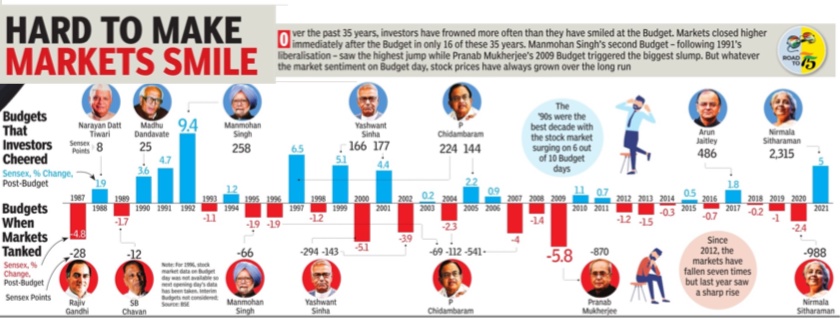
From: February 2, 2022: The Times of India
See graphic:
Budgets which investors cheered; Budgets when markets tanked, 1987-2001
2014-22

From: February 2, 2022: The Times of India
See graphic:
How Sensex swayed on budget days, February 1, 2014- 21
2016: Highest rise ever
The Times of India, Mar 02, 2016
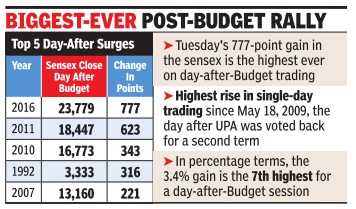
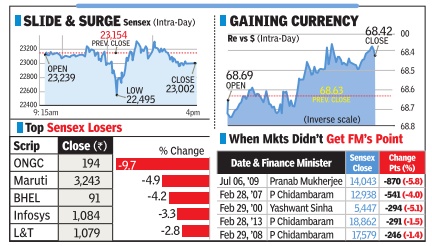
See graphics:
Top 5 day-after surges post budget, till 2016
Slide and surge, sensex, intra-day; Top sensex losers; Gaining currency, rupee-dollar and Finance Minister and change in points: till 2016
Swinging Sensex on Budget day, 2008-2017
Changes in the stock market on the Budget Day, February 1, 2017
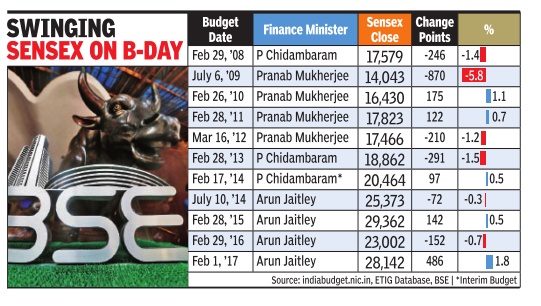
7th heaven: Sensex flies 777, highest rise in 7 yrs
Investors on Dalal Street lif ted the sensex by a record 777 points-its biggest single-session gain on the day after the Budget.Investor wealth rose by Rs 2.5 lakh crore overall. The jump of 3.4% to 23,779 was also the biggest singleday gain in nearly seven ye ars since the sensex shot up 2,111 points on May 18, 2009, the day Congress-led UPA government returned to office.
Investors were enthused by finance minister Arun Jaitley's resolve to stick to the fiscal deficit target of 3.5% of GDP and proposed investments aimed at boosting the rural economy as well as India's infrastructure. Hopes of a rate cut by RBI also propelled the sensex. Foreign investors bought net stocks worth Rs 1,761 crore during the day, a sig nificant reversal from a net nificant reversal from a net outflow of Rs 2,100 crore on the Budget day . Twenty-seven of the top 30 BSE companies closed higher with ITC, ICICI Bank and Maruti leading the surge. The day's strong buying also lifted investors' wealth measured in terms of BSE's market capitalisation, to Rs 88.17 lakh crore from Rs 85.67 lakh crore on Monday .
According to Amar Amba ni, head of research, IIFL, sev eral measures, announced in disparate areas, promise posi tive yield in the medium to long term. “Farmers and budding entrepreneurs have handsome takeaways, so does the bottomend of the salaried class.
The rural and farm sector allocations including MGNREGA, irrigation, electrification, crop insurance, interest subvention and cooking gas subsidies are laudable as they would make a difference to countless BPL families across the length and breadth of the country ,“ he said. “The silver lining, however, was that the fiscal deficit target of 3.9% (of GDP) was met and target of 3.5% has been maintained for fiscal 2017. This raises expectations of a rate cut from the RBI,“ Ambani said. The FM's decision to not raise fiscal deficit for next fiscal had also started a rally in the bond market on Monday which continued on Tuesday , although it was slightly muted with the yield on the benchmark 10-year government security softening by 3 basis points (100 basis points =1percentage point) to close at 7.60%. In the last three sessions yield has softened 16 basis points as bond prices rallied (bond prices and yields are inversely related).
“There is a high chance of a rate cut by the RBI, but may not come immediately ...that could come in RBI's April 5 policy meeting,“ a bond dealer said.
2017: an even higher rise
Sensex vaults 486 points, most ever on Budget day, Feb 2, 2017: The Times of India
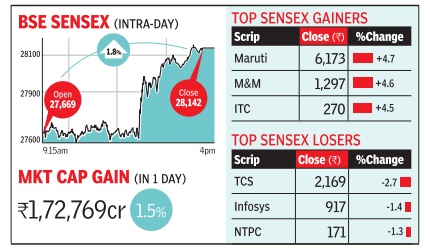
In the biggest points gain for the sen sex on a Budget day ever, the index jumped 486 points (1.8%) on Tuesday , riding on the government's resolve for fiscal discipline and economic reforms and the relief announced for taxpayers. The sensex ended the day at 28,142 -a three-month high. Foreign investors, however, were muted in their response to the Budget. Their net buying of stocks was worth Rs 93 crore, while bullish domestic funds recorded anet inflow figure of Rs 1,134 crore. The day's rally was led by auto and banking & financial sector stocks, while IT and pharma continued to witness selling pressure due to emerging business hurdles in the US, the largest export market for these companies.
The day's gains, which made investors richer by over Rs 1.7 lakh crore with BSE's current market capitalisation now at nearly Rs114 lakh crore, were also boosted by short covering by speculators who had gone short, anticipating a tough Budget for the market in particular.
Brokers said some of the FM's proposals signalled that India is open for business. “The Budget affirms India's commitment to globalisation and an open market against a global trend of protectionism. The abolition of FIPB is a strong signal towards the same, as is the clarification on tax on indirect transfer,“ said Leo Puri, MD, UTIMF .
Brokers also feel that the tax proposals are a long-term positive. “The proposed reduction in tax will be constructive for improving overall compliance and collection efficiency . This will also be positive for greater flow of savings to formal channels,“ said Shilpa Kumar, MD & CEO, ICICI Securities.
2018: 2nd biggest post-budget loss, 9th worst in single session
In second-biggest post-Budget Day loss, sensex dives 840 pts, February 3, 2018: The Times of India
See graphic:
The reaction of India’s stock markets to the union budget of 2018
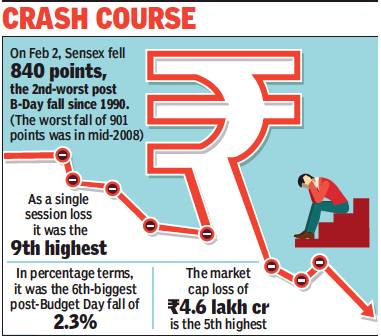
From: In second-biggest post-Budget Day loss, sensex dives 840 pts, February 3, 2018: The Times of India
The Day After: Details Of Govt’s Mega Schemes Emerge And Markets Take A Beating
Yields On Bonds Move Up, Rupee Falls Against $
The reintroduction of long-term capital gains (LTCG) tax sent Dalal Street on a selling spree on Friday, as the sensex crashed 840 points (2.3%), its secondsharpest post-Budget day fall ever by points, and closed just a tad above 35K.
Bond yields rose on fears that the government might not be able to manage the fiscal deficit target, which also affected investor sentiment on the stock market.
After plunging to a low of 35,006 points in late trades, the sensex closed at 35,067 while the Nifty lost 256 points to close at 10,761. The day’s session left investors poorer by Rs 4.6 lakh crore, with BSE’s market capitalisation now at Rs 153.7 lakh crore. In terms of market cap loss, it was the fifth-worst day for Indian investors.
In addition to LTCG tax and rising bond yields, lack of clarity about the applicability of LTCG tax and its grandfathering clause in case of foreign investors also led to strong selling.
In a post-market conference, the government, however, clarified that all LTCG tax-related rules would apply to foreign funds also.
A section of the market said the sell-off is expected to continue in the coming week as well. “The worst is not behind us yet. Markets need to stabilise after such a major shakeout,” said Arun Kejriwal, director of investment advisory firm KRIS. “It will not only take some time, but also some more value erosion,” he added.
Several foreign portfolio managers said they were taking a close look at the possible impact of LTCG tax on their India investments. These fund managers have in recent times banked on a stable rupee. But the burden of an extra tax could now force them to rethink their investment models, which may lead to some selling in the coming weeks, market players said.
Interestingly, though, in Friday’s session, foreign funds clocked a net inflow of Rs 950 crore, compared with Rs 509 crore net selling by domestic funds. There are additional concerns that some of the foreign players may shift part of their portfolio to Singapore, where the exchange is planning to launch derivative contracts on the 50 stocks that constitute NSE’s Nifty index.
Rising bond yields fuel global mkt volatility
The yield on the benchmark 10-year government securities rose to a high of 7.68%, from 7.17% when it was introduced on January 5. A rising gilt yield puts pressure on banks to hike their lending and deposit rates. “Global market volatility led by rising bond yields, profit-booking (Indian markets had posted a strong monthly gain before the Budget) and concerns on deteriorating macro-economic conditions were the probable reasons for the market fall,” said Sandeep Chordia, EVP strategy, Kotak Securities.
During the day, the sell-off in the stock market also caused the rupee to weaken. It closed at 64.06 to the dollar, more than a month-low figure.
2018: Worst ever 4-day post-budget fall
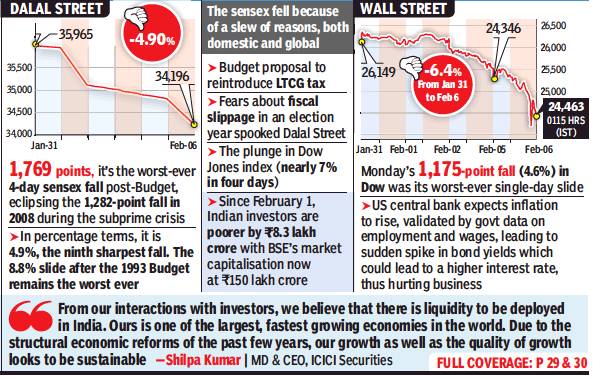
From: February 7, 2018: The Times of India
See graphics:
The worst ever 4-day post-budget fall of the Sensex after a union budget took place in 2018, but was aggravated by international problems as well
2019: fall is second-worst in 11 years
July 9, 2019: The Times of India

From: July 9, 2019: The Times of India

From: July 9, 2019: The Times of India
Post-Budget sensex fall is second-worst in 11 years
Investors Lose ₹3.2 Lakh Cr As BSE Index Plunges 793 Pts
Mumbai:
Equity investors lost close to Rs 3.2 lakh crore on Monday after the sensex dropped 793 points—the sharpest fall since October 2018. The index also recorded its secondworst post-budget performance in a decade as markets expressed their disappointment with the government’s decision to tax buyback of equity by companies. Foreign portfolio investors turned net sellers over concerns that a tax on the rich would also apply to FPIs since they invest under the trust route. Besides the tax on buybacks and general negativity over the government decision to increase taxes on the rich, global markets were affected after stronger US jobs data reduced chances of a rate cut by the US Federal Reserve. Emerging markets sentiment also dimmed after Turkish markets crashed following the sacking of its central bank governor. The 30-share sensex tanked 907 points in the intra-day trade before settling at 38,720.6 points, showing a sharp loss of 792.8 points or over 2%. The broader Nifty of the NSE tanked 252.6 points, or 2.1%, to close at 11,558.6 points. The biggest post-Budget decline by the sensex in the last decade was in February 2018, when the benchmark index closed 840 points lower.
According to analysts, the tax on share buybacks will discourage companies from announcing buying back their equities. They said buybacks act both as a safety net for shares and add liquidity. The selloff in equities and fears of fewer rate reductions by US Fed, resulted in the rupee losing its three-day gaining streak. The domestic currency declined by 24 paise to close at 68.66 against the US dollar.
Among Indian stocks, public sector banks were hit after Punjab National Bank classified Bhushan Power and Steel as a fraud. PNB’s shares closed 11% down after it accused a defaulting borrower Bhushan Power and Steel of a Rs 3,800 crore fraud. HDFC Bank shares closed nearly 3% down over concerns of a slowdown in lending, particularly in consumption segment. Bajaj Finserv shares fell 10% after Sanjiv Bajaj warned that demand was easing with TV sales not picking up despite the cricket World Cup. In the last two sessions, the total erosion in market cap has been over Rs 5 lakh crore. The government’s proposal to get companies to increase public holding to at least 35% of their capital (from 25%) has raised the spectre of equity dilution.
“The market fall today was because of concerns over future fund flow into the secondary market and scam revelations at PNB. Hike in surcharge in the Budget will have an adverse impact on high-end consumption, as well as reduce the investible surplus of highincome individuals, whose money was the mainstay of mutual funds, PMSes and the midcap segment. Fears of prolonged slowdown in consumption also caused sell-off in autos and NBFCs linked to the consumption story,” said Amar Ambani, president & research head, YES Securities.
2021: 2nd-highest rise ever

From: February 2, 2021: The Times of India
See graphic:
3 biggest budget day rises, till 2021
Best B-week in 10 years
February 6, 2021: The Times of India
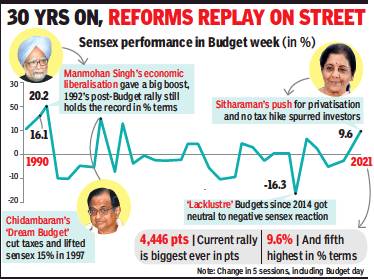
From: February 6, 2021: The Times of India
Sensex sees best B-week in 10 yrs with 4.4k pt rise
Hits 51K For First Time, Nifty Breaches 15k
Mumbai:
The Budget rally on Dalal Street continued for the fifth consecutive session on Friday, taking the sensex past the 51k mark for the first time ever, but it closed below that level. With SBI, Kotak Bank and HDFC Bank leading, the sensex touched an all-time high of 51,073 points, before ending 117 points up at 50,732 — its highest ever closing level. On the NSE, the Nifty too crossed the 15k mark for the first time, but closed below that level at 14,924 with a 29-point gain.
Since February 1, the sensex has added 4,446 points, or 9.6%. This is the highest gains in terms of both points and percentage for the index in one week after the Budget over the last 10 years. In terms of percentage gains, the 26% over one week after Manmohan Singh’s 1992 Budget tops the charts (see graphic).
The day’s gains in the sensex, however, overshadowed the selling in small and midcap stocks. BSE data showed while the midcap index lost 0.9%, the smallcap one lost a marginal 0.3%. As a result, despite the sensex closing with a slight gain of 0.2%, investors were left poorer by about Rs 14,000 crore with the BSE’s market capitalisation now at Rs 200.1 lakh crore. The RBI’s decision to maintain status quo on rates also did not have any impact on the market, brokers and dealers said.
According to HDFC Securities head (retail research) Deepak Jasani, the advance-decline ratio again ended in the negative, reflecting some profit-taking in midcaps, as the attention has shifted to largecaps lately. BSE data showed that compared to 1,289 stocks which closed higher, 1,688 stocks closed lower.
A day after the budget
2014-22
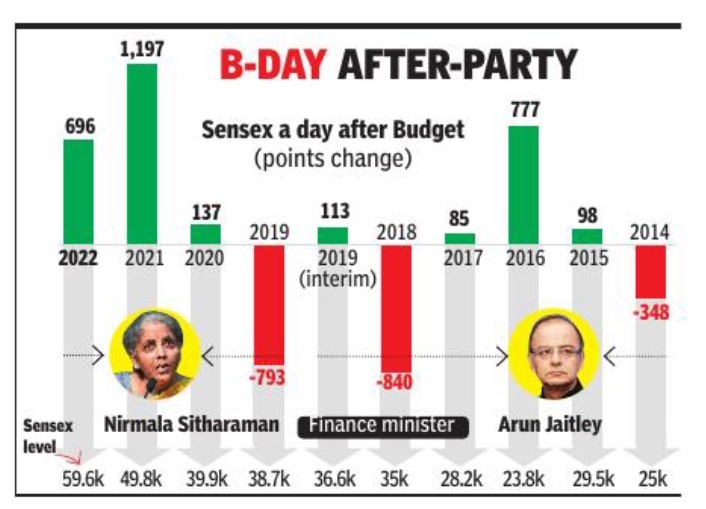
From: February 3, 2022: The Times of India
See graphic:
Sensex, a day after the budget, 2014-22
Weightage of sectors
1986-2021 Jan
Mayur Shetty, January 22, 2021: The Times of India
An unusual feature of the sensex is the dominance of the financial sector. From zero weightage when the sensex was first published in 1986, financials account for 42% of the free-float market capitalisation of the sensex. This is highly unusual for a large economy like India, where industry and nonfinancial services account for a significant part of the GDP.
Rather than correct itself, the weightage of financials in the sensex could go up further and a key driver would be the listing of LIC, which is expected to be valued at between Rs 11-15 lakh crore. Also, more banks are expected to raise capital, which will increase the quantity of banking stock floating around.
There are several reasons for the financialisation of the Indian equity markets. The primary among this is the death of manufacturing activity. Many of the steel, textiles and auto companies in the original sensex are doing poorly and there have been no competitors to take their place.
Another theory is that services such as IT and financials have thrived in India because they are less dependent on infrastructure and therefore less affected by factors that determine the ease of doing business. But while the IT sector provides services for the world, the financial sector focus is entirely on domestic markets. The third reason is the regulator — the RBI — which has leaned on promoters to dilute their shareholding and forced banks to reduce stake in subsidiaries.
YEAR-WISE STATISTICS
2014-19, May

From: May 24, 2019: The Times of India
See graphic, ' Changes in market capitalisation under the NDA government, 2014>2019 '
2015>2019 FY
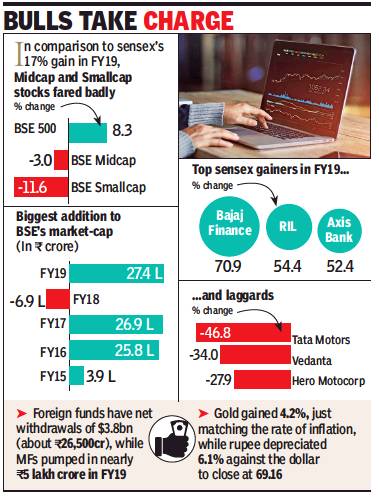
From: Foreign funds drive sensex up 17% in FY19, March 30, 2019: The Times of India
See graphic:
Changes in market capitalisation, FY 2015>2019
2019 FY: Foreign funds drive Sensex up 17%
Foreign funds drive sensex up 17% in FY19, March 30, 2019: The Times of India
Institutional Investors Lap Up Blue Chips, Midcaps And Smallcaps Lag Index Rise
Fiscal year 2019 will be remembered as the year when large institutional investors concentrated their buying in blue chips, leaving aside midcap and smallcaps for others. Consider this: The sensex gained a little over 17% during the year, while the smallcap index on the BSE closed 11% lower and the midcap index was down 3%. The Nifty has gained a little over 14% during the year.
FY19’s 17% rise in the sensex was also the best in the last four years. In FY16, the index had seen a 9.4% loss after rising nearly 25% in FY15, data showed. While the sensex had witnessed a loss in FY16, the BSE had recorded a Rs 25.8-lakh crore jump in market capitalisation, indicating a rally in midcap and smallcap stocks and also several new listings in the market that year.
Foreign funds are driving the current stock market rally with the sensex and Nifty expected to scale fresh all-time highs soon while bank Nifty is already at a new peak. Arun Kejriwal, director, KRIS, an investment advisory firm, said: “We are on track to hit new highs in the sensex and Nifty. Bank Nifty is already at a new high. The interests of FPIs in India has picked up considerable steam and about Rs 45,000 crore was invested in the last few weeks in equities. With election results still eight weeks away, markets will have a free run for at least a fortnight,” he said.
On the sectoral front, banking, energy and IT have outperformed with FMCG and pharma also recording good gains.
Going ahead, after the Lok Sabha elections are over, there could be some profit taking as concerns about a slowdown in the global economy and the US-China trade war-related issues could again come to the forefront. In times of profit-taking or selloff, usually, small and midcap stocks suffer the most.
The year also saw the rupee slide to a new all-time low level against the dollar, trading near the 75-level. However, the recent strong inflow of foreign funds has brought the Indian currency around the 69-per-dollar level.
Gold, one of the most popular assets for Indians, saw some volatility but is now trading at the Rs 32,500-per 10-gram level, a gain of about 4% in the last one year, which is just about matching the rate of inflation in the economy. Although globally gold is considered a natural hedge against inflation, in India it is a popular asset.
On the global front, US President Donald Trump said trade talks with China are progressing “very well”, as top negotiators from the two countries on Thursday began another round of meetings to resolve their tariff dispute.
Elsewhere in Asia, Hang Seng rose 0.96%, Shanghai Composite soared 3.2%, and Nikkei ended 0.82% higher on Friday. Global oil benchmark Brent crude futures rose 0.44% to $68 per barrel.
2020

From: January 5, 2021: The Times of India
See graphic:
The Sensex in 2020.
2021
Nov 4, 2021: The Times of India

From: Nov 4, 2021: The Times of India

From: Nov 4, 2021: The Times of India
Sensex ends Samvat 38% higher, best in 12 years
Investors on Dalal Street were richer by about Rs 99 lakh crore during Samvat year 2077 that ended on Tuesday, riding on strong acrossthe-board buying that also led to a 38% jump in the sensex to its close at 59,772 points. The rise was the best in the last 12 years while the gain in investors’ wealth—in terms of BSE’s market capitalisation—was the best ever, official data showed.
The year ended with BSE’s market cap at Rs 266 lakh crore ($3.6tn), which elevated India to the sixth largest market spot in the world in terms of market value. Samvat 2077—the calendar followed by mainly the trading community on Dalal Street—will go down as one of the best years in terms of returns and the regularity with which the leading indices hit new alltime highs, analysts said. TNN
Samvat 2077: ‘Year of unicorns and tech cos’
Metals, banking & financial services, and software exporters led the rally while pharma and FMCG stocks witnessed muted gains in prices. The gains came on the back of nearly Rs 1.25 lakh crore worth of net buying of stocks by foreign institutional investors, while domestic institutions, which include mutual funds, insurance companies, banks and others financial companies, were net sellers at about Rs 34,700 crore, CDSL and BSE data showed.
The year will also be marked as the year when new age consumer-facing tech-enabled companies, for years being privately held by a handful of private equity-venture funds, started getting listed. The trend, often called private going public by merchant bankers and analysts, was led by food delivery company Zomato and soon followed by CarTrade. A host of such companies, that include FSN Ecommerce (Nykaa), PB Fintech (Policybazaar) and One 97 Communications (PayTM), are now in various stages of going public.
According to Yesha Shah, head of equity research, Samco Securities, Samvat 2077 could be termed as the year of unicorns and technology companies. Technology adoption has now become mainstream, Shah wrote in a note to clients.
See also
Sensex <> The stock market: India <> Mutual Funds: India <> Currency: India <> Gold in the Indian economy <> Sovereign credit ratings: India <> Corporations, corporate performance: India
